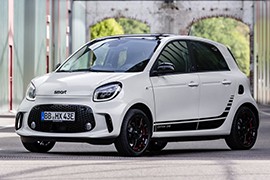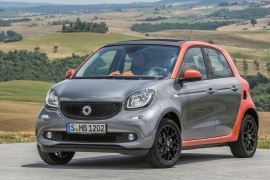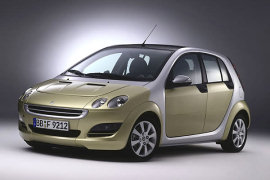SMART forfour Models/Series Timeline, Specifications & Photos
First production year: 2003
Engines: Electric, Gasoline, Diesel
Body style: Hatchback
A small step for mini lovers, a big step for the Smart ForFour. Smart has made a few changes from the original 2004 Smart ForFour, which wasn't a big success, to the EQ ForFour. The EQ ForFour is very much a city/town car created to reduce CO2 emissions, especially in urban areas.
The transition to pure electric power has been straightforward for Smart. They replaced the engine and the fuel tank with an electrical engine, which is impressively done right, practicality being unaffected by the switch to battery power.
The exterior is Designed and built in collaboration with its rival Renault Twingo, the new Renault Twingo same four doors supermini city car. A facelift for 2020 resulted in mostly visual changes, adding a smoother bonnet, larger grille, new lights, and different wheel designs.
From the front, the futuristic towncar design is completed by its square Full-LED headlamps with main & dipped beam, integral indicator & daytime running lights, more robust shoulder line,, and larger honeycomb grille.
The interior is upgraded with a new 'floating' touchscreen infotainment system lifted from the Renault Twingo, dominating the dashboard on top-spec models. Also, it has newly designed cupholders and a place for smartphones, giving a high-quality feeling. The older version and discontinued petrol-powered Smart ForFour had a dash-mounted rev counter.
The new EQ version has an easy-to-read power and charge dial. For more fun, Smart added the option for Android Auto, but unfortunately, it has no Apple CarPlay. The entry-level Pure model version is well equipped with a 3.5-inch color instrument panel display, LED daytime running lights, climate control, USB and aux connections, Bluetooth, cruise control with a speed limiter, stop-start and electric windows fitted as standard.
Some features are also available such as a panoramic roof and heated seats. For a town car, the navigation system is essential to be good, so the smart has a TomTom-based satnav. In terms of practicality, the rear seats are best to be used by children, being a bit too tight for adults.
Performance is quite good if considering the Smart EQ ForFour is a four-seat full-electric city car. It’s agile around town. It has 82 horsepower and a healthy 160 Nm while offering zero emissions, smooth power delivery, and a range of up to 99 miles from a single full charge, which is pretty decent.
The new ForFour has nothing to deal with the previous model. The new model of ForFour has Crosswind Assist (fitted as standard) moderates braking when the car encounters a strong gust of wind, which is a significant improvement. Other features, including a forward collision warning and lane-keeping assist, are also available.
Safety also improved, the ForFour scored four stars overall, with the new high-strength steel chassis also proving to be as strong and as safe as a Mercedes C-Class in frontal collisions, making it a good choice for those who want small towncar with zero emissions.
The tiniest member of the Mercedes-Benz family was the little SMART, available with two or four doors. The 2014 SMART forfour offered the basic mobility solution for four adults in a small package.
SMART forfour was built in Slovenia, at a Renault factory, the car was developed together with the French car manufacturer, which builds the Twingo model based on the same vehicle. They shared around 70% of their components, but some parts and panels were particular to each and every car. The concept of a small vehicle built on a specially designed safety cell, named Tridion, rear engine and gearbox plus a four-door version made the second generation of SMART a good choice for urban mobility.
From the outside, the SMART forfour shared the same fascia with its two-door brother. There was the same grille with a cross-drilled panel. But, unlike the first generation, it didn't feature a front-engine. The high greenhouse was needed to offer enough room inside. The 2014 forfour featured a pair of doors in the back with an almost 90 degrees opening for easy access.
Inside, the forfour featured a minimalist design for the dashboard, with a pillar-mounted tachometer. The infotainment system was mounted on the center console and it could show various information about the car and the sound system as well. The four seats inside the car were good for adults.
For the drivetrain, SMART forfour featured two engine choices mated to a standard 5-speed manual. An option of a 6-speed automatic with dual-clutch is available. The biggest advantage for its rear-engine with rear-wheel drive system was a very tight turning circle of just 8950 mm (352”) wall to wall.
When DaimlerChrysler and Mitsubishi joined their forces to produce a supermini hatchback for the European market, the result was the Mitsubishi Colt/SMART Forfour.
With little or zero experience in the segment, Mercedes-Benz trusted the Japanese carmaker to design an appropriate platform for the supermini vehicle. Unlike the ForTwo sibling, the ForFour could carry up to five people inside and still be easy to park.
Unlike the wedged-shaped Colt, the ForFour featured rounded edges and curved body panels. Its four round headlights resembled those installed on the ForTwo's first generation. On the sides, the silver color that covered the A- and C-pillars, the rocker panels, and the roofline, showed the safety cell built for the unibody construction. The design team took inspiration from the smaller sibling when they made the plastic moldings from the wheel arches and the three-lamp system for the taillights.
Inside, the carmaker created an upscale interior, fit for a premium brand. Apart from the base trim levels, which offered just the minimum comfort features, the upper trim models received a leather-clad interior, wood or aluminum adornments, and a Mercedes-Benz sourced infotainment system. As an option, the carmaker even installed a panoramic glass roof.
Under the hood, SMART installed Mitsubishi engines, either gasoline or turbo-diesel. All versions provided front-wheel drive and five-speed manual gearboxes.


